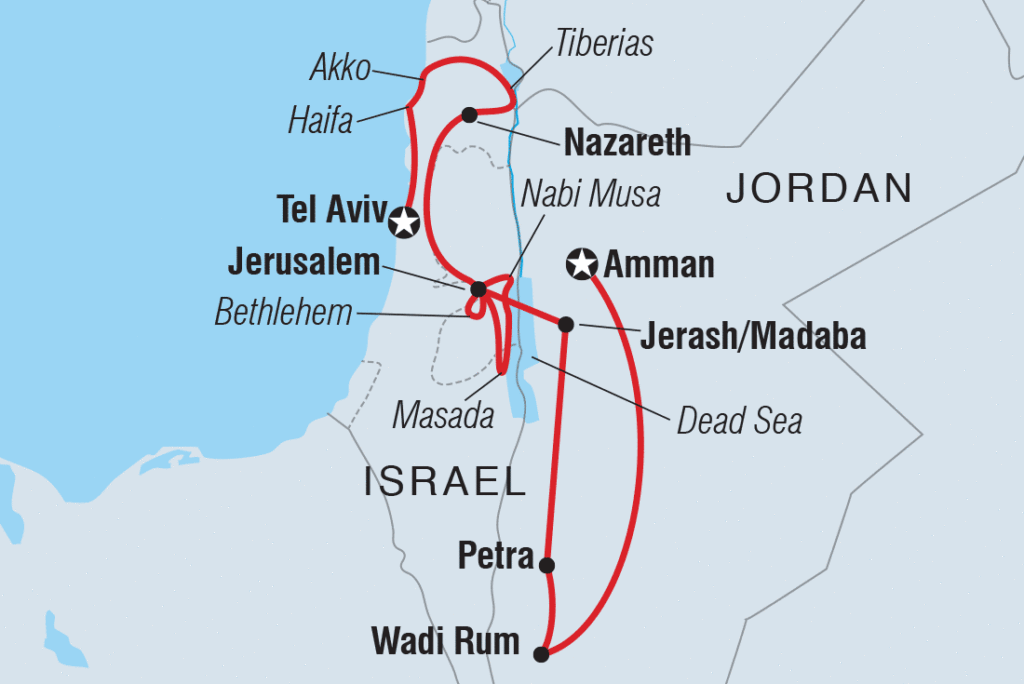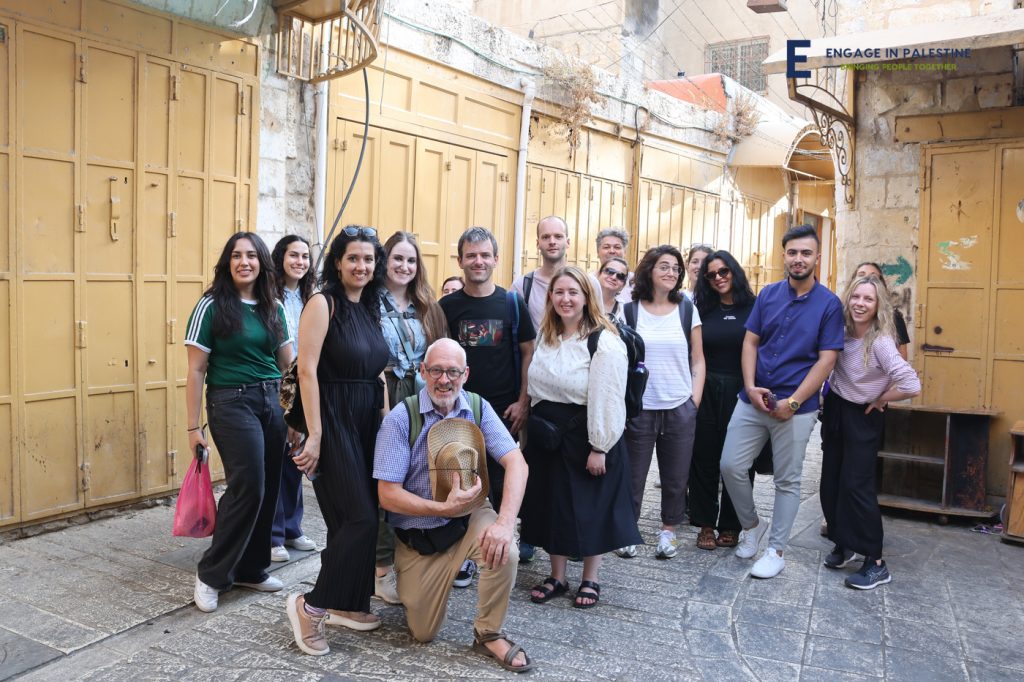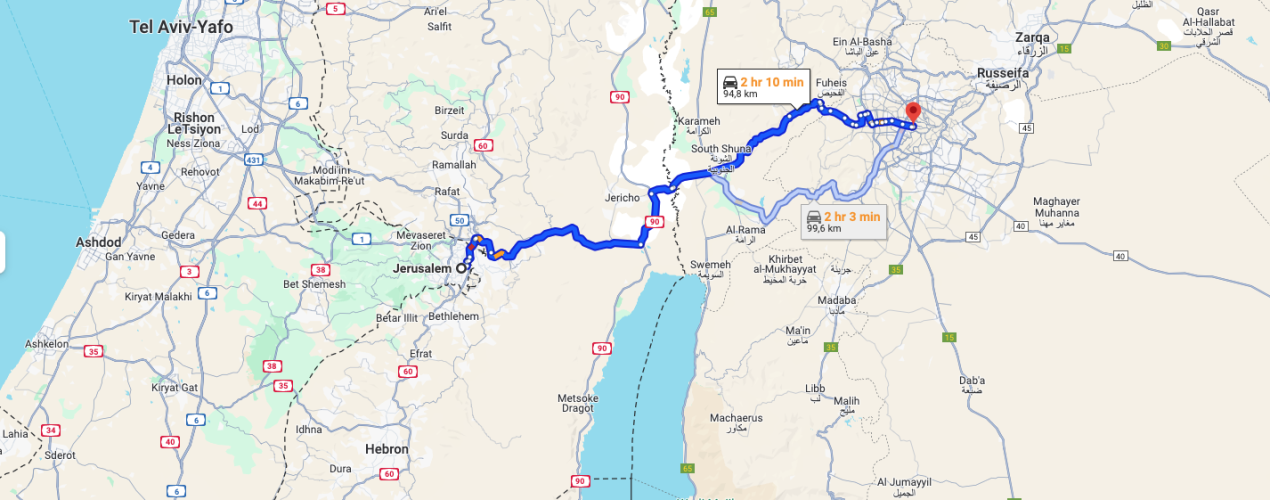Traveling from Jordan to Palestine: All travel to and from the territories is controlled by Israel. While possible to travel via Israel’s Ben Gurion Airport, the security for this entry is very difficult to pass. We recommend that you plan to travel via Jordan when planning a trip to the West Bank.
So what are the options? Palestine does not have its own airport, so traveling between Jordan and Palestine is done by crossing over land. There are three land crossings: King Hussein Bridge (also called Allenby Bridge), Sheikh Hussein Bridge, and the Wadi Araba Crossing. Which crossing you choose can depend on your destination (e.g., whether you plan to enter Israel or the West Bank), and whether your destination is in the center, the north, or the south.


| Category | Details |
|---|---|
| Land Crossings | 1. King Hussein Bridge (Allenby Bridge) – Main route to the West Bank. 2. Sheikh Hussein Bridge – Northern route into Israel, not for Palestinians. 3. Wadi Araba Crossing – Southern route into Israel, not for Palestinians. |
| King Hussein Bridge Details | – Most common and busiest route. – Used by all Palestinians for international travel. – Visa on arrival in Jordan (60 JOD for entry & exit). – Shuttle bus fee: ~25 JOD. – Expect strict Israeli security checks. – Limited hours on Fridays/Saturdays; closed on holidays. |
| Sheikh Hussein Bridge Details | – Located in northern Jordan. – For tourists and Israelis only (no Palestinians). – Limited transport options; taxi from Irbid recommended. – Open Sun-Thu: 8:30 AM – 6:00 PM; Fri: 8:30 AM – 4:00 PM; Closed on Saturdays. |
| Wadi Araba Crossing Details | – Located in southern Jordan, near Aqaba. – For tourists and Israelis only (no Palestinians). – Can cross by foot (no shuttle bus needed). – Open Sun-Thu: 9:00 AM – 8:00 PM; Fri-Sat: 9:00 AM – 6:00 PM. – Transport from Eilat via Be’er Sheva to Jerusalem/Hebron. |
| Visa & Entry Requirements | – No separate visa for the West Bank. – Israeli tourist visa issued on arrival (up to 90 days). – Palestinians with a green ID can only use King Hussein Bridge. – Travelers with stamps from certain Arab countries may face scrutiny. |
| Transportation After Crossing | – King Hussein Bridge: Taxi to Jericho → Service (shared taxi) to Hebron, Ramallah, Jerusalem, Bethlehem. – Sheikh Hussein Bridge: Taxi to Tiberius/Nazareth → Shared taxi to Jerusalem → Service to Hebron. – Wadi Araba: Bus/taxi to Be’er Sheva → Bus/taxi to Jerusalem → Service to Hebron. |
Below, we outline more details about each entrance and some pros and cons.
Table of Contents
King Hussein Bridge (Allenby Bridge) – The Most Common Route
The King Hussein Bridge crossing is the most common and busiest land crossing between Jordan and Palestine. This is the crossing that all Palestinians must use if they intend to travel anywhere overseas. Their only travel option is from Queen Alia Airport in Jordan, as they cannot use Israel’s Ben Gurion airport.
So how exactly do you cross King Hussein Bridge into the West Bank? Let us tell you!
You should be able to get a visa on arrival in Jordan, or you can easily apply for one beforehand online. An entry and exit visa costs 60 Dinar and allows you to cross the border both ways. Check the official Jordanian Government website for up-to-date visa fees.
From Queen Alia Airport, you might book a night or two in Amman City, or you might want to head right to the crossing. Staying a night might be easier, as you can organize a taxi pick up from the airport and a drop-off the next day at the border. One of our volunteers recently paid 27 dinars for this ride. For those more familiar with Jordan or confident in navigating local public transport, you can also take a JETT bus from the city to the border crossing.
Once you arrive at the border, you will cross Jordan’s exit immigration like at the airport. A person from the Jordanian border staff will take your passport before leading you to a shuttle bus, which will take you to the border entrance. This is where you will cross through Israeli border security. There are three different terminals and buses – one for Israel residents, one for West Bank Palestinians, and one for tourists. You must pay a fare for the shuttle bus, which is around 25 Jordanian dinars.
Once you reach the Israel border, your luggage will be scanned, and you will pass through immigration. If you’re only traveling with hand luggage, make sure to keep it with you.
Before entering the terminal, stop at a second counter where your passport will undergo an initial assessment. You will then pass inside the terminal, where Israeli immigration will issue you a visa. As this crossing goes directly into the West Bank, there is a chance that you may be pulled aside for questioning. This may take anywhere from a couple of minutes to a couple of hours.
Following the immigration, there is a final passport check. You’ll then head to the arrival hall,l where your checked luggage is delivered. Collect your belongings, continue past the customs counters, and exit the terminal.
It is important to note that the border crossing has limited operating hours on Fridays and Saturdays and is closed on some national holidays. Try to plan your flight so that you don’t cross on these days, or book somewhere to stay in Amman and see some of the city!
Other Border Crossings to the West Bank
While the King Hussein Bridge crossing goes directly into the West Bank, two other crossings you can use from Jordan will take you directly into Israel. They are the Sheikh Hussein Bridge in the north and the Wadi Araba Crossing in the south. As these crossings go directly into Israel, they may be slightly easier to pass through in terms of security. However, they are also further away from Queen Alia Airport and more difficult to travel to.
1. Sheikh Hussein Bridge
This crossing is in Jordan’s north and is for travelers heading to northern Palestine or Israel. The crossing is only used for Israeli citizens and tourists. No Palestinians are allowed to cross using this route. Transport directly to the border is much more limited. The best option is to take public transport to Irbid in Jordan’s north and then a taxi to the border crossing location. This crossing is open Sunday – Thursday: 8:30 am – 6:00 pm (last entrance at 4:30 pm) and Friday: 8:30 am – 4:00 pm (last entrance at 2:30 pm). It is closed on Saturdays.
2. Wadi Araba Crossing
Situated in the far south near Aqaba on the Jordanian side, this crossing is for those wishing to enter and travel within the south. It is also only for Israeli citizens and tourists. This crossing is open Sunday – Thursday: 09:00 am – 08:00 pm (last entrance at 6:00 pm) and Friday-Saturday: 09:00 am – 6:00 pm (last entrance at 5:00 pm).
This crossing can be done by foot without the need for a shuttle bus between the Aqaba exit and Eilat entrance. The JETT bus company has regular buses from Amman to Aqaba if you want to travel via this route. However, traveling to the West Bank from the other side can take a long time and be more difficult.
Ensure you submit the Electronic Travel Authorization (ETA-IL)
As of January 1st, 2025 Israel requires an Electronic Travel Authorisation to be submitted before you travel to the country. The check-in desk at the airport will request it. The form will ask you for your personal details, your travel date and how long you intend to stay, and whether you have been denied entry to Israel before. Make sure to fill in and submit prior to booking your flight, in case it is not approved. If approved, the ETA is valid for 2 years, and you may travel for up to 90 days at a time during that period.
Visa and Entry Requirements
Important: Always check official government websites for specific visa information regarding the country that issued your passport! Currently, there is no separate visa for entering the West Bank. The visa you need is an Israeli tourist visa. These are usually issued on arrival for a period of up to 90 days. Sometimes, they are issued for less time, so make sure to double-check what you have been granted.
Israel’s border control can be very strict. People who hold a Palestinian passport and a green ID can face a lot of problems trying to re-enter the West Bank, and are only allowed to cross from Jordan via the King Hussein Bridge. They are not allowed to cross into Israel at either of the other three crossings, or use the airport at Ben Gurion.
Travelers with certain stamps on their passports may also face trouble crossing into Israel. This is especially true of other Arab countries, especially those with a difficult relationship with Israel, like Lebanon or Egypt. Similarly, an Israeli stamp on your passport can cause trouble with onward travel to some places. That is why when you enter Israel, your passport will not be stamped. Instead, you will receive a small piece of paper stating the length of your stay. It is important to keep this paper with you at all times if you are asked to produce it at a checkpoint or while checking into a hotel.
Transportation Options After Crossing
So you’ve crossed into Israel or the West Bank—congratulations! Now, how do you get to your next destination?
1. From the King Hussein Bridge Crossing:
This busy crossing has the most transportation options for onward travel into Israel or Palestine. From the entry point, you can take a private or shared taxi directly to the city of Jericho. From there, you can take a Service to major cities like Hebron, Ramallah, Jerusalem, and Bethlehem.
The larger shared taxis, called Service (pronounced Servees), ordinarily wait to depart until they are full of passengers going in the same direction. The driver will usually stand out in front of the vehicle and shout out their destination. Make sure you check the fare amount with the driver before getting on the vehicle. If you’re having trouble finding a Service, it is very likely that someone will approach you to ask where you are going and point you in the right direction (especially if you are carrying luggage).
Service fares are paid in cash either during or at the end of the trip. If it’s during, you will likely see people passing money to the driver at the front. Make sure you have enough to get close to the fare amount, as the driver might not always carry enough change.
2. From Sheikh Hussein Crossing
The Sheikh Hussein crossing is not as busy as King Hussein Bridge, but traveling south to Hebron takes a lot longer. For this route, you must take a taxi to Tiberius or Nazareth, then a shared taxi to Jerusalem. You can take a Service to Hebron from East Jerusalem near the Damascus Gate light rail station.
3. From Wadi Araba
This journey is significantly longer than crossing through King Hussein Bridge, but it might be nice if you want to see Aqaba and the Red Sea in Jordan’s south. You will enter the Southern Israeli city of Eilat from the Wadi Araba crossing. From here, you will be able to take a bus or shared taxi to Be’er Sheva. There are two options for onward travel: another bus or shared taxi to Jerusalem or a train to Tel Aviv.
You can take the train and light rail from Tel Aviv to Jerusalem, then take a service down to Hebron near the Damascus Gate light rail station. From Jerusalem, you can go straight to Hebron the same way.
Engage in Palestine is always happy to arrange a private taxi for you if you don’t feel confident navigating public transport immediately!
Travel Tips & Things to Expect
Coming to Palestine is a bit different from your usual overseas holiday. As you plan your travel, you should be aware of and prepare for some things.
Security checks – what questions to expect and how to answer
Due to the current security situation, entering and exiting the country is a bit more difficult for foreigners than usual. Worried that they will come to support Palestinian organizations or travel in the West Bank, some foreigners may be pulled aside for questioning at the border.
If this happens to you, our best advice is to stay calm, interact with people pleasantly, and answer their questions as close to the truth as possible without explicitly mentioning that you’re coming to volunteer in Palestine. Mentioning Palestine or expressing any support for Palestine will likely mark you as a threat. Some of the questions our volunteers have been asked at the border include
- Why are you coming to Israel specifically now?
- Do you have any friends or family here?
- Where will you be staying?
- Are you friends with Muslims?
One tactic the border guards may use is to ask the same question repeatedly, to try and find cracks in your story, or to make you feel unsteady. Just stay calm and say the same answer you initially told them. Some things you can do to help make your entrance into Palestine more likely:
- Do not pack or wear anything that could hint to the authorities that you are supportive of Palestine, have any intention of spending time in the West Bank, or associate you with Islam or any other Arab country. Sometimes, your luggage may be searched, and possessing such items could prompt further questioning.
- Try to dress nicely, such as in smart casual or business wear. Anyone who ‘looks’ like a stereotypical activist might be flagged for questioning.
- Try not to mention the West Bank; if you do, call it Judea and Samaria
- Have a clear itinerary spanning the time you intend to stay in Israel, and make sure you can answer questions about what sights you might see, what hotels you might stay in, or chat cities you might visit.
- Do not mention that you are coming to study any Arabic.
- Please try to delete any messages, contact numbers, photos, or search history on your phone that link you to Palestine. Not often, but sometimes, phones may be confiscated and searched.
Currency exchange and accepted payment methods
The currency in Palestine is the New Israeli Shekel. While some businesses do use card machines, the West Bank is primarily cash-based, and it is best to assume that you will need to pay for most things with physical money.
Notes generally come in 200, 100, 50, and 10 Shekel denominations, and coins come in 10, 5, 2, 1, and half-Shekel denominations.
Most ATMs in Israel should work with international cards. Within the West Bank, the Bank of Palestine is usually the most reliable.
Check with your bank or a currency converter tool to see the current exchange rates.
Language barriers and some useful Arabic phrases for travelers
While many Palestinian people speak at least some English, learning some colloquial Arabic before you arrive is a great idea. This can help you get to your destination. The local people will also be very happy to know that you are trying to speak some of their language.
- Hello! – Marhaban
- How much? – Aadesh?
- Thank you – Shukran
- Where? – Ween
- Toilet – Hamam
- Money – Musari
- Goodbye – Ma’a Salama
For more basic Arabic to help with your stay, you can read our guide to helpful Arabic phrases.
Personal Experiences from Volunteers
The following is an account from Sara, one of our January 2025 volunteers from the United States.
“I arrived at Queen Alia airport in January 2025 and got the double entry visa on arrival that will let me enter Palestine and leave again through Jordan within three months. I stayed overnight at a hostel in Amman to recover from travel, and they organized a taxi for me to get to King Hussein crossing the next day.
The border was busy and pretty confusing, but I just followed some other travelers and was directed to the shuttle bus once I left the Jordanian border. It’s a bit confusing, but if you get lost they will show you to the right place. When I arrived at the Israel immigration, I was asked a few questions about my time in Israel – where I would go and what I would see.
I said I wanted to see some religious sights, and they asked me which sites. So I pivoted and said I wanted to learn Hebrew by immersing myself in the community, and they waved me through. The whole process took about an hour and a half.
On the other side of Immigration, I got a shared taxi to Jerusalem. There was a checkpoint between the border and Damascus Gate where an armed guard checked our passports. I travelled south to Hebron the next day. Talking with the Israeli immigration can be a bit nerve-wracking, but I just tried to stay calm. My advice is to not mention any cities in the West Bank, and try to play yourself off as dumb (but not too dumb) if they raise anything.
Alternative Routes & Special Considerations
The other way to enter the West Bank is through Israel’s Ben Gurion Airport. A few years ago, this was our primary recommended route. However, given the current security situation, this route is most likely to result in foreigners being turned away.
Planning for travel through Ben Gurion starts before you even book. We recommend choosing an airline that is not Israeli and flying from a country outside the Arab world. Israeli airlines tend to have much higher security before takeoff and have turned people away before they even board the plane at their point of origin.
Upon arrival in Ben Gurion, the same process applies in terms of passing through immigration. There is a high likelihood that you will be questioned about why you have decided to travel to Israel, particularly now. We recommend staying in Tel Aviv of Jerusalem for a night or two before crossing into the West Bank. If you are able to pass immigration, travel to Hebron is relatively simple.
First, you can catch a train one stop from the airport to Jerusalem’s Yitzhak Navon station. Directly outside the station is a light rail system. Use that to travel to the Damascus Gate stop. This is the stop closest to East Jerusalems, the Muslim side of the city. When you alight at the stop, walk back the way you came for a few meters and take your first left down Al Anbeya Street.
Your next left after that will be the street where all the service-shared taxis leave from. Listen for the driver yelling, ‘Al Khaleel!’ or ask someone to help you find the right Service. Negotiate the price with the driver, and settle in for the ride!
“I entered through Ben Gurion Airport in January of 2025. I spent two minutes at the immigration desk on the way in and was granted a 3-month visa immediately and without questioning. As I understand it I was very lucky, as security at Ben Gurion Airport has increased a lot in recent times, and some volunteers have been turned away either before their flight or when they land at Tel Aviv.” – Eva, 2025 Volunteer
Summary
Traveling to the West Bank can be tricky in the current setting—that is the reality of the occupation. However, the Engage in Palestine team is here to offer support and advice every step of the way. Over 2,000 students and volunteers have safely joined us since our founding in 2011.
Contact Us
Should you have any questions, please do not hesitate to contact us at:
WhatsApp:+972 599 479 880
Website: https://volunteerinpalestine.org/
EC Website: https://excellencenter.org/
Instagram: https://www.instagram.com/excellence.center
Facebook page: https://www.facebook.com/ExcellenceCenter



